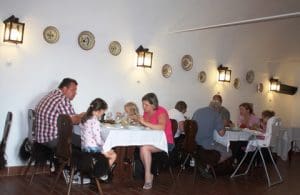
Mr Nagy’s charming ceramics shop.
Champion Hungarian chef and master of black pottery, József K Nagy, celebrates a family achievement that has enhanced a London restaurant
By James Brewer
József K Nagy is a master craftsman in eastern Hungary, well known on two fronts: for producing distinctive black ceramics, and for his culinary skills.
Mr Nagy – whose business is based at Hortobágy on the Great Plain of Hungary – is currently taking pride in one further achievement, this time on the part of his son, who returned home in the summer after completing a prestigious commission for a UK client.

Master potter: József K Nagy senior.
His son, who is also named József K Nagy, was asked to build a tile stove along traditional lines for a large London restaurant. In this task he was able to call on the extensive ceramic heritage of his family and his detailed knowledge of the workings of fireplaces like those common in central Europe in the 14th century.
This was the latest news from the modest Mr Nagy senior. He mentioned it as we were about to say goodbye after inspecting the display shelves at the attractive pottery shop he runs.
Black pottery is produced in few locations. While Mr Nagy has his studio in Hortobágy, he hails from Nádudvar, which is best known in the region for its matt black pottery. The Danube town of Mohács and workshops in Romania are similarly centres of this speciality.
In the market town of Nádudvar, some 40 km from the city of Debrecen, the craft may date back to the early days of Ottoman rule. Local clay with high ferric oxide content is dried and allowed to ‘mature’ for months, before being worked on the wheel and baked for many hours in the kiln, where wood smoke contributes to the ebony colour. Such techniques have been passed through the generations for hundreds of years, and have been called “the art of fire and earth.”

Style for the table: black pottery vase.
Master potter Mr Nagy etches delightful flower designs into the pieces he produces. Vases and jugs of the type once made to carry water to the peasants working in the outposts of the plains now lend a rustic feel to kitchens in modern homes and are popular souvenirs for tourists.
While at Mr Nagy’s shop, we learned that he also happens to be an award-winning chef.
As a cook, his speciality is slambuc (pronounced shlumbutz), a country dish traditionally served to shepherds and horsemen of the Puszta (the plains). It is a heavy stew, meant to sustain those who spend many hours away from their homes, looking after animals.
Mr Nagy’s culinary talents are known throughout the region and beyond. In 2014 Mr Nagy was invited to Debrecen University Summer School to cook slambuc for the students. Organisers of the school are keen to introduce students who attend from many countries to the taste and mode of preparation of traditional Hungarian food.
Slambuc became a popular dish because it could be made in areas where cooking facilities were rudimentary and ingredients were scarce. It was originally cooked for two to three hours in a cauldron over an open fire, with a large amount of lebbencs (a type of flat pasta torn into irregular pieces), potatoes, pork fat, water, and salt.

Tucking into traditional food at the Hortobágy Big Inn.
Instead of lebbencs, broken-up, very thin lasagna sheets can be used. Some newer recipes call for bacon, sausage, tomato, other vegetables, and paprika to be added – and it is still a cheap way of producing a filling meal. On a kitchen stove, it will take 45 minutes to cook.
The complicated part comes once the water has evaporated, and that is to shake the contents at the bottom of the pot or cauldron to the top so that the crispy part forms an even surface.
Some cooks sprinkle the finished dish with crackling. “Serve with pickled hot paprika and a glass of red wine, ” suggests one website recipe. Jó étvágyat! (Bon appétit in Hungarian).





